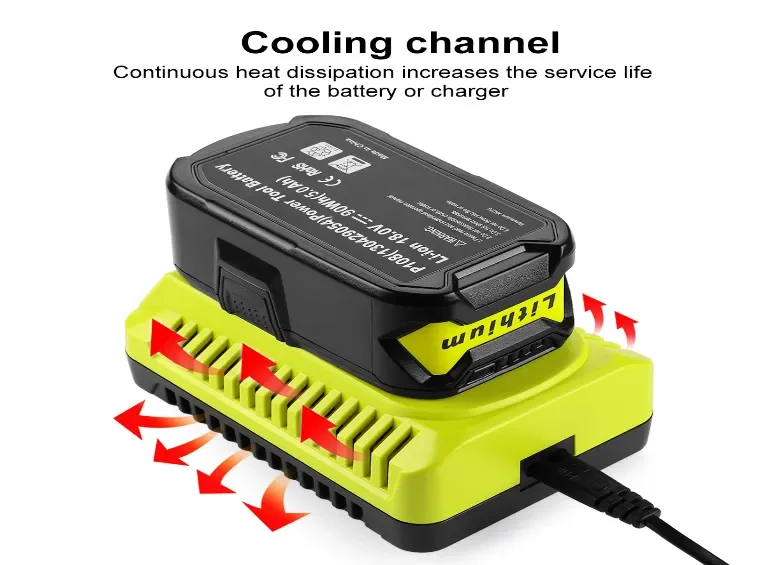Charger Safety: Preventing Overcharge & Thermal Runaway on Ryobi Packs
Lithium-ion power is a miracle of modern tools—until it isn’t. The terms overcharge and thermal runaway represent every Ryobi user’s worst nightmare: a battery fire. The good news? These events are incredibly rare and almost entirely preventable with the right chargers, BMS safeguards, and safe workflows. This guide explains what the risks really mean, how smart chargers and batteries defend against them, and how you can create safe habits to eliminate fear, protect crews, and maintain productivity on the jobsite.

What overcharge and thermal runaway actually are
Overcharge happens when cells are pushed beyond safe voltage or continue receiving current after full. Like inflating a balloon past its limit, it creates gas, heat, and internal pressure.
Thermal runaway is a chain reaction where rising heat triggers further breakdown and more heat, escalating into fire or explosion within seconds. Ryobi packs include protections, but misuse, poor chargers, or physical damage can bypass them.
First line of defense: Charger design features
Smart Ryobi chargers prevent faults using CC/CV charging, current limiting, and soft-start. They perform pack ID handshakes to match charging profiles, use thermistors for temperature sensing, and enforce automatic termination when full. Fault lockouts stop abnormal charging. Dual-bay models also isolate each bay so one bad pack doesn’t compromise the other.
Key takeaway: A well-engineered charger makes overcharge nearly impossible. Cheap knock-offs often cut corners on these exact circuits, raising the risk of failure.
Second line of defense: Battery/BMS safeguards
Inside Ryobi One+ packs, the Battery Management System (BMS) provides:
-
Over-voltage, over-current, and thermal cutoffs
-
Cell balancing to prevent single-cell overcharge
-
Internal fuses, PTCs, and vents as last-resort fail-safes
Chargers and BMS must work hand-in-hand. If either is missing, incompatible, or poorly designed, termination may be incomplete—raising danger of runaway.
Safe charger & battery pairings
-
Always use chargers engineered for Ryobi One+ packs with full ID and CC/CV control.
-
Avoid “dumb” DC bricks or passive adapters.
-
If aftermarket, only choose chargers with clear documentation, safety certifications, and tested compatibility.
7 essential safe charging habits
-
Charge only on a hard, non-flammable surface.
-
Never leave packs charging completely unattended—especially overnight.
-
Charge in a cool, ventilated space, away from direct sun or heaters.
-
Stop using and safely retire any swollen, cracked, or leaking pack.
-
Let packs cool down after heavy use before charging.
-
Use OEM or certified chargers only—never “no-name” knockoffs.
-
Store long-term at ~30–50% charge in moderate temperatures.
Monitoring & early detection
Catch issues before they escalate:
-
Warning signs: unusual heat, odor, swelling, smoke, or error LEDs.
-
Tools: use an IR thermometer for spot checks.
-
Charge time tracking: too short or too long sessions indicate trouble.
-
Fleet logs: track underperforming packs and retire them early.
Jobsite emergency response
If a pack overheats, smokes, or ignites:
-
Unplug the charger if safe.
-
Move the pack outdoors with insulated tools to a fireproof surface.
-
Never attempt to reuse a damaged pack.
-
Do not soak in water unless trained—follow fire service guidance.
-
Evacuate if flames spread.
-
Quarantine and dispose per hazardous waste protocols.
Fleet policies & administrative controls
-
Standardize certified chargers across crews.
-
Keep inspection and retirement logs.
-
Train workers on pre-charge checks and emergency steps.
-
Limit unattended charging.
-
Rotate both packs and chargers to reduce stress and heat buildup.
Troubleshooting matrix
-
Fault LED only with one pack → Pack BMS/ID fault → Quarantine and test on another charger.
-
Pack runs hot while charging → Damaged/high-resistance cells → Stop, isolate, retire.
-
Charger cycles on/off → Poor contact or handshake → Clean contacts, reseat, retest.
-
Poor runtime despite full charge → Aging cells → Load-test and plan replacement.
How to choose the safest Ryobi charger
Your safest option isn’t always OEM—it’s the charger with the most reliable and redundant safety features:
-
Advanced IC chipset to prevent overcharge
-
Redundant temperature sensors (battery + charger internal)
-
High-quality components that withstand stress
-
UL, CE, RoHS certifications to prove compliance
At [Your Brand], safety isn’t a feature—it’s the foundation. Our Ryobi-compatible chargers are built with layered protection to give you complete peace of mind. [Link to Charger Page]
Short Technical FAQ
Q: Can a Ryobi smart charger overcharge a pack?
A: Not if both charger and pack are compatible. CC/CV termination and BMS cutoff protect against it.
Q: Is it safe to charge a warm pack?
A: No. Always wait until the pack cools into its specified safe range.
Q: When should a pack be retired?
A: Signs include swelling, overheating, runtime below 50–60%, or repeated charger lockouts.
Consumer Safety FAQ (JSON-LD ready)
Q: Is it safe to leave my Ryobi battery on the charger overnight?
A: While modern chargers use maintenance modes, best practice is to remove once full and avoid long unattended sessions.
Q: What should I do if my Ryobi battery starts swelling or smoking?
A: 1) Unplug the charger immediately. 2) Move the pack outdoors on non-flammable ground with insulated tools. 3) Do not attempt to extinguish with water. 4) Call fire services if fire occurs.
Q: How do I know if my current charger is safe?
A: Look for UL/CE marks. If it’s a no-name brand, runs excessively hot, or is physically damaged, replace it with a certified model from a trusted brand.
Conclusion
Preventing overcharge and thermal runaway is a system-wide effort. Chargers, BMS, and safe user habits must align. By prioritizing certified chargers, adopting strict charging workflows, and preparing clear emergency protocols, you reduce risks, protect crews, and extend battery life.
Don’t gamble with safety—invest in a charger built with peace of mind as the priority. [Explore Safe Charger Options →]